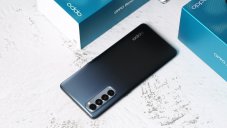Oppo Reno4 Pro
$333 | 29999
- 6.5" 1080x2400 pixels
- 48MP 2160p
- 8GB RAM Snapdragon 720G
- 4000mAh Li-Po
Phone Finder
- Acer alcatel Allview Amazon Amoi Apple Archos Asus AT&T Benefon BenQ BenQ-Siemens Bird BlackBerry Blackview BLU Bosch BQ Casio Cat Celkon Chea Coolpad Cubot Dell Doogee Emporia Energizer Ericsson Eten Fairphone Fujitsu Siemens Garmin-Asus Gigabyte Gionee Google Haier HMD Honor HP HTC Huawei i-mate i-mobile Icemobile Infinix Innostream iNQ Intex itel Jolla Karbonn Kyocera Lava LeEco Lenovo LG Maxon Maxwest Meizu Micromax Microsoft Mitac Mitsubishi Modu Motorola MWg NEC Neonode NIU Nokia Nothing Nvidia O2 OnePlus Oppo Orange Oscal Oukitel Palm Panasonic Pantech Parla Philips Plum Posh Prestigio QMobile Qtek Razer Realme Sagem Samsung Sendo Sewon Sharp Siemens Sonim Sony Sony Ericsson Spice T-Mobile TCL Tecno Tel.Me. Telit Thuraya Toshiba Ulefone Umidigi Unnecto Vertu verykool vivo VK Mobile Vodafone Wiko WND XCute Xiaomi XOLO Yezz Yota YU ZTE
Oppo Reno4 Pro Summary
It can be said that Oppo's Reno line is one of the clearest proofs of the pace at which Chinese smartphone makers are going. Just over a year ago, the original Reno launched in the high-end segment, and the “shark-fin” camera had attracted a lot of attention. Shortly thereafter, the brand released another mid-range smartphone called Reno 10X Zoom.
Only 14 months later, the Reno line has now entered the 4th generation (not to mention the side releases like Reno Z, Reno Ace, ...), and the Reno4 Pro has no shark fins and telephoto cameras. The target user also changed from the mid-range and high-end segment to the mid-range, completely giving way to the high-end segment for the Find X2.
That's not a bad thing. The shark fin camera is unique but not practical, as evidenced by how smartphone makers are shifting towards the punch-hole design. With increasingly improved hardware (and software), we can take photos at 2x or even 5X with acceptable quality without the need for a telephoto camera. The more accessible price is obviously something every consumer wants. At the moment, the 5G model of the phone is yet to reach India, but you can get the 4G model in the Indian market. The OPPO Reno4 Pro price in India is Rs. 34,990 for the base option.
OPPO Reno4 Pro: Display
Reno4 Pro equipped with a 6.5-inch screen, Full HD + resolution, Super AMOLED panel for maximum brightness (according to Oppo) is 1100 nits. However, it is worth noting that the Reno4 Pro's screen now has a 90Hz refresh rate instead of just 60Hz like the Reno3 Pro. You can manually switch between 60Hz, 90Hz, or simply let the phone chooses it based on the app you are using.
In addition, the Reno4 Pro screen also has 100% DCI-P3 color coverage, HDR10 support for vivid and accurate colors, especially when watching HDR content on Netflix, Youtube. True blacks and wide contrast are familiar features of Super AMOLED panels that we all know.
The Reno4 Pro supports Dolby Atmos, but because it is only a single speaker, the speakerphone quality is only "usually mid-level". It has high volume and the sound doesn’t get distorted at maximum volume but the sound quality is not really outstanding.
OPPO Reno4 Pro: Battery Life
The eReno4 Pro is currently having the fast charging support on the market, with a maximum capacity of 65W thanks to Super VOOC 2.0 charging technology. According to our test, Reno4 Pro can fully charge its 4,000 mAh battery in just 36 minutes, as announced by Oppo.
The 4,000mAh battery capacity might not be as high as other phones, but the rapid charging speed, you won’t need to care much about that. However, it is worth noting that the 90Hz refresh rate mode makes the device consume more power. Compared to the Reno3 Pro with similar screen size and the same 4,000 mAh battery, the Reno4 Pro consumes 10% more battery.
OPPO Reno4 Pro: Performance
In terms of configuration, both Reno4 Pro and Reno4 are equipped with Qualcomm's Snapdragon 720G chip, which is great news after OPPO suddenly switched to MediaTek's Helio chip on the Reno3. However, compared to the Chinese version Reno4 Pro with a more powerful Snapdragon 765G, the SND720G is certainly not as powerful.
The biggest reason for this "differentiation" is because the 5G network is not widely available outside of China, other countries including India are only in the experimental phase. Considering the Reno4 Pro only costs about 8-9 million VND after deducting all gifts, the Snapdragon 720G chip is not too bad, as Oppo has to consider the cost in other aspects of the smartphone.
Measured by AnTuTu Benchmark v8.4.3 software, the Reno4 Pro achieved 258,325 points. Meanwhile, with GeekBench 5, Snapdragon 720G on the handset scored 560 single-core points and 1716 multi-core points. Thus, compared to Helio P95 on Reno3 Pro, Qualcomm's processor gives better performance by 10-15%.
Selecting two familiar titles: Dead Trigger 2 and PUBG Mobile, Reno4 Pro - like many other smartphones using Snapdragon 720G - deliver a smooth experience if you accept a little downgrade in graphics.
8GB of RAM is enough for the Reno4 Pro to handle multitasking comfortably, but sometimes you might experience a slight lag, possibly due to the Snapdragon 720G and Adreno 618 GPU not strong enough to "carry" the 90Hz screen.
In terms of software, Reno4 Pro comes pre-installed with Android 10, running along with the new ColorOS 7.2 interface. According to Oppo, ColorOS uses AI to predict the next user app and preload it, improving app opening time. This feature learns users' habits, which means that the longer you use it, the smoother it will be (in theory), but due to the relatively short time to experience the device, I have not had the opportunity to test the feature.
OPPO Reno4 Pro: Camera
The camera system on the Reno4 Pro offers standard and ultra-wide cameras, but it doesn’t have a telephoto lens, which is a big downside in my opinion.
If you are familiar with OPPO smartphones, you will see that they also tuned the Reno4 Pro’s camera to deliver vibrant and bright photos that are great to share on social networks. However, in return, you will see that the photos have heavy digital noise reduction and over-sharpening if you take a closer look at the photos on a big screen.
Low-light scenes are where the OPPO Reno4 Pro shows its weaknesses. Using the standard mode, the outcomes had a lot of noise and weren’t sharp. It did perform better with Night Mode, but not by a large margin. Photos looked brighter and slightly sharper, but the over noise reduction significantly lowered the details of the photos.
Oppo Reno4 Pro Full Specifications
- Dollas $333 Buy in Flipkart >
- Rupee ₹29999 Buy in Flipkart >
- Technology GSM / HSPA / LTE
- 2G bands GSM 850 / 900 / 1800 / 1900 - SIM 1 & SIM 2
- 3G bands HSDPA 850 / 900 / 1700(AWS) / 1900 / 2100 - International
- 1, 3, 5, 8, 38, 40, 41 - Asia Pacific
- 4G bands 1, 2, 3, 4, 5, 7, 8, 18, 19, 20, 26, 28, 38, 39, 40, 41 - International
- Speed HSPA 42.2/5.76 Mbps, LTE-A
- Announced 2020, July 31
- Status Available. Released 2020, August 05
- Dimensions 160.2 x 73.2 x 7.7 mm (6.31 x 2.88 x 0.30 in)
- Weight 161 g (5.68 oz)
- Build Glass front, plastic back, plastic frame
- SIM Dual SIM (Nano-SIM, dual stand-by)
- Type Super AMOLED capacitive touchscreen, 16M colors
- Size 6.5 inches, 103.5 cm2 (~88.3% screen-to-body ratio)
- Resolution 1080 x 2400 pixels, 20:9 ratio (~402 ppi density)
- Protection Corning Gorilla Glass 5
- HDR10 90Hz refresh rate 500 nits typ. value (advertised)
- OS Android 10, ColorOS 7.2
- Chipset Qualcomm SM7125 Snapdragon 720G (8 nm)
- CPU Octa-core (2x2.3 GHz Kryo 465 Gold & 6x1.8 GHz Kryo 465 Silver)
- GPU Adreno 618
- Card slot microSDXC (dedicated slot)
- Internal 128GB 8GB RAM, 256GB 8GB RAM
- UFS 2.1
- Modules 48 MP, f/1.7, 26mm (wide), 1/2.0", 0.8µm, PDAF 8 MP, f/2.2, 119˚ (ultrawide), 1/4.0", 1.12µm 2 MP, f/2.4, (macro) 2 MP, f/2.4, (depth)
- Features LED flash, HDR, panorama
- Video 4K@30fps, 1080p@30/60/120fps, gyro-EIS
- Modules 32 MP, f/2.4, 26mm (wide), 1/2.8", 0.8µm
- Features HDR
- Video 1080p@30/120fps, gyro-EIS
- Loudspeaker Yes
- 3.5mm jack Yes
- WLAN Wi-Fi 802.11 a/b/g/n/ac, dual-band, Wi-Fi Direct, hotspot
- Bluetooth 5.1, A2DP, LE, aptX HD
- GPS Yes, with A-GPS, GLONASS, GALILEO, BDS, QZSS, GNSS
- NFC Yes (market/region dependent)
- Radio FM radio
- USB 2.0, Type-C 1.0 reversible connector, USB On-The-Go
- Sensors Fingerprint (under display, optical), accelerometer, gyro, proximity, compass
- Non-removable Li-Po 4000 mAh battery
- Charging Fast charging 65W, 60% in 15 min, 100% in 36 min (advertised) SuperVOOC 2.0
- Colors Starry Night, Silky White
- Models CPH2109
- Camera Photo
- Loudspeaker -28.8 LUFS (Average)
- Battery life Endurance rating 96h
Oppo Reno4 Pro News

Review - Oct 25, 2020
OPPO Reno 4 Pro Review: Premium Design, Ultra-Fast Charging, Mediorce Performance

Mobile - Aug 03, 2020
OPPO Reno4 Pro Launched In India: 65W Fast Charging & Gorgeous Design

Mobile - Jun 06, 2020











